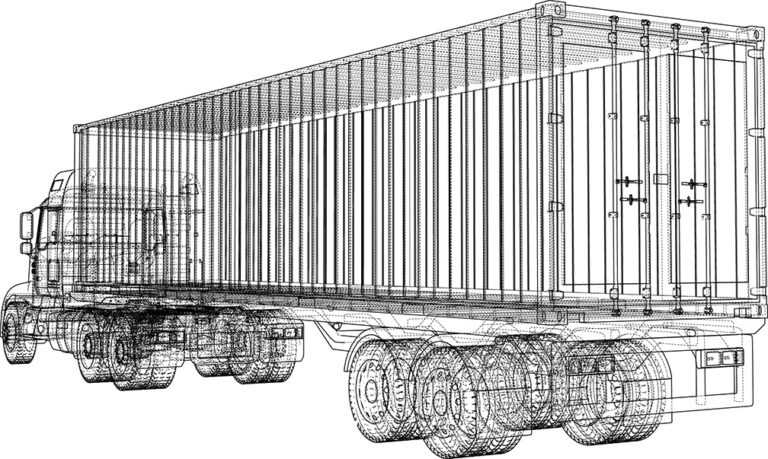Carriers typically carefully spec the trucks they purchase in order to obtain enough power to meet customer needs while conserving as much fuel and operating income as possible. Modern tractors come with numerous options, including drive train choices as well as aero options like fairing, cab extenders, and more.
When it comes to trailers, however, manufacturers have less to work with. After all, a dry van trailer is a rectangular box. Dump, tank, and flatbed trailers must be designed for maximum strength, which can’t be compromised for weight savings or aerodynamic efficiency.
At the same time, trailers typically remain in service much longer than tractors. The return on technology investments that improve fuel economy pays off for twice the time period of tractors, or even more.
For years, the trailer industry focused on weight savings to improve efficiency, offering lighter composite materials in construction and weight-saving components when possible. Low-profile tires with decreased rolling resistance became the norm for most applications.
On the aerodynamics front, trailer skirts have been the most visible of treatments on dry van trailers, while most other trailer types haven’t changed much, if at all. What has changed is that aero products that used to be aftermarket items installed by the customer or dealer are being installed by manufacturers.
Wabash National Trailer, for example, offers two versions of its “AeroSkirt” brand of trailer skirt, the DuraPlate and the CX, as well as products from other suppliers, including rear fairings and mud flaps.
“We can assemble other manufacturers’ solutions upon a customer’s request,” explained Wabash Product Development Engineering Manager Aaron Smith.
When it comes to aero technology, Smith knows that customers consider products with an eye toward return on investment (ROI).
“Both side aerodynamic skirts and rear aerodynamic systems are very competitive in terms of achieving fuel savings performance,” he explained, “but it really depends on the specific device in terms of manufacturer and model. However, on average, the rear aerodynamic devices have a higher initial cost that results in a longer ROI.”
FlowBelow Director of Sales Operations Katie Breitschopf says wheel covers should be considered, too.
“FlowBelow’s Trailer Wheel Covers have been track-tested to save 0.81% on fuel, and (were) road-tested by several mega-fleets to show an even higher return,” she remarked. “The covers pay for themselves in Year 1 or early in Year 2, and they deliver returns for the remaining life of the asset. That makes the ROI incredibly attractive.”
Breitschopf recommends wheel covers to every fleet, along with side skirts, where applicable.
“We don’t sell them, but we recommend trailer skirts; their bang for the buck is huge,” she said.
Carriers looking for additional fuel savings can find it in another FlowBelow product.
“Our AeroSlider, which is a kit that includes wheel covers and fairings that smooth the turbulent air flow across the wheels of the trailer, as well as flow-through mudflaps, has been SmartWay certified to save 2.07% in fuel,” explained Breitschopf.
FlowBelow wheel covers and fairings are offered as standard equipment on some tractor models. Breitschopf hopes trailer OEMs will follow suit.
Another product, this one manufactured by Eco Flaps, is a specially designed flow-through mud flap that claims to improve fuel economy by more than 1%. Rather than simple slots in the mud flap to allow air to pass through, the Eco Flaps product features molded, wing-shaped channels that reduce air resistance and, as a bonus, greatly reduce the amount of road spray in wet conditions.
Improving aerodynamics isn’t the only way to maximize trailer fuel economy. Some carriers are looking at lift axles as an alternative to the usual tandem axles.
“Some of the main benefits of lifting an axle can include improved payload, operational flexibility, improved maneuverability, increased fuel efficiency, extended tire and component life, and reduced road tolls,” explained Hendrickson Director of Global Marketing and Communications Mark Slingluff.
Lift axles have traditionally been popular for vocational applications such as dump or heavy-haul. Increasingly, buyers are looking at them for fuel-saving applications.
“Hendrickson offers various lift kits on the Hendrickson suspension model and trailer design,” said Slingluff.
Multiple options for operation of the lift axle are available, including those that integrate with the vehicle’s main suspension and those that operate independently. A “smart” option is offered that raises and lowers the axle automatically based on air spring pressure.
Lift axles aren’t the only way suspension options can save fuel, however. Hendrickson also manufactures tandem axle slider suspension systems for trailers, including dry van and refrigerated units. Their ULTRAA-K UTKNT 40K offering is touted as “the lightest slider system in the industry by nearly 100 pounds,” according to the company’s website.
It pays to learn about suspension options offered by OEMs, including the weight savings of individual components.
Sorting through the mountain of fuel-saving claims of manufacturers can be a daunting task. Fortunately, real testing information for many products isn’t hard to find, thanks to Mesilla Valley Transportation Solutions (MVTS). The MVTS lab is an independent third-party testing organization formed with the partnership of Mesilla Valley Transportation and InnoMetric MPG, a testing provider for the racing industry.
MVTS offers private testing for individual carriers and manufacturers, but also offers a list of certified products that includes testing results for each. Interested parties can find independent test data for many of the products they might consider adding to trailer orders. Test summaries as well as full testing reports are available.
Test results are offered in terms of gallons of fuel saved for every thousand miles driven. Fuel savings are also expressed in terms of percentage, but this is considered a less accurate way to report results.
MVTS-certified products include tires, lubricating oils, solar panels, and other products, in addition to aero products. One product, a grill guard for protecting the front of the truck, was tested for potential increase in fuel consumption, which proved to be minimal.
Purchasing trailers can be as simple as choosing a trusted brand at the best price, but purchasers who carefully consider fuel saving options may find the ROI to be well worth the time it took to research the options.
Cliff Abbott is an experienced commercial vehicle driver and owner-operator who still holds a CDL in his home state of Alabama. In nearly 40 years in trucking, he’s been an instructor and trainer and has managed safety and recruiting operations for several carriers. Having never lost his love of the road, Cliff has written a book and hundreds of songs and has been writing for The Trucker for more than a decade.








